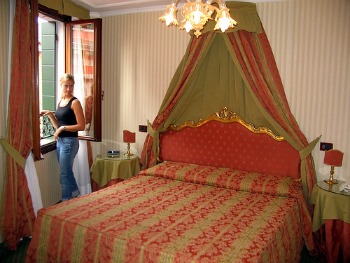What the Italy Hotel Star Classification System Means
 Booking a hotel in Italy can feel a bit like shooting blindly, especially when it’s your first trip and you have no idea what you’re looking for.
Booking a hotel in Italy can feel a bit like shooting blindly, especially when it’s your first trip and you have no idea what you’re looking for.
It’s easy, then, to gravitate toward something that looks familiar – something you think makes sense, and that you can compare properties by.
A star system seems promising, but as you’ll see it can be confusing.
Here’s what you need to know about the Italy hotel star system.
How many stars are in Italy’s hotel rating system?
As is the case in the United States and many other countries, Italy has a hotel rating system that ranges from 1-5 stars.
Is Italy’s hotel star system the same as in other countries?
No – this is a critical point, and a common misconception. You see stars, you see the same number of stars in the range, and you think it’s the same system. It’s not.
Okay, what are the stars in Italy’s hotel classification system based on, then?
In Italy, as in some other European countries, the number of stars a property has is designated by the government of that country. There’s a checklist that each hotel is put through and then a final score is produced that determines how many stars that hotel has. Things like the size of the lobby, the proximity of the lobby to guest rooms, and whether there’s an elevator in the building can be the deciding factors in whether a hotel is a 2-star or 3-star property.
If you’re raising an eyebrow and wondering what these stars have to do with the rooms themselves, you’re not alone. Things like whether the rooms have private bathrooms and even how many towels are provided will be counted toward that hotel’s number of stars, but there’s no method for scoring “cute” or “quaint” or “pretty” or anything remotely subjective.
To make matters even more complicated, the star system is only partly national – some of the regulations are regional, meaning a 3-star hotel in Venice might not have to meet the same criteria as a 3-star hotel in the Cinque Terre. They’ll be close, mind you, but they’re not working off of the same checklist.
What can be expected at different star levels?
This isn’t a comprehensive list, but here are a few common hotel amenities, and what star levels of hotels are supposed to have them in Italy:
- 24-hour Reception – 5-star hotels have 24-hour reception in most cases, but are not required to; other star levels must have a reception desk open for at least 12 hours a day.
- Bathrooms – Even 1-star hotels don’t need to have a private bathroom for every bedroom (they must have at least one bathroom for every three rooms or every six guests). Properties with 4-5 stars will have private bathrooms in each room (although they may be small), and many 3-star hotels will also have private bathrooms in each room.
- Breakfast Service – This is generally standard in hotels with 3-stars and above, but not required for 1- and 2-star hotels.
- Change of Linens/Towels – How often linens and towels must be changed depends on the number of stars the hotel has, and varies from once a day to once every three days at a minimum.
- Cleaning Service – Rooms must be cleaned at least once per day, regardless of the number of stars, unless otherwise directed by the hotel guest.
- Heating & Air Conditioning – Heat in the rooms is required for all star levels (unless a hotel is closed every winter), but air conditioning is only required in 4- and 5-star hotels.
Does this mean we should ignore the stars on Italy hotels?
No, you shouldn’t ignore them – but you also shouldn’t rely solely on them. When you’re searching for hotels in Italy, keep these things in mind along with how many stars a property has:
- Many hotels occupy old buildings that don’t allow for expansion, so the rooms in even some 3- and 4-star hotels may seem quite small when compared with similarly-starred hotels in the U.S. If you want giant American-style rooms, you’ll probably need to seek out 4- and 5-star hotels (perhaps even chain hotels) away from historic centers in newer buildings.
- As mentioned, the star system in Italy has nothing to do with aesthetics, charm, or any of the things that capture a traveler’s heart. In other words, a 1-star hotel could have as much if not more charm than a 4-star hotel in the same city – even if it doesn’t have a 24-hour reception desk and the lobby is too small.
- It’s not a good idea to automatically assume that 1- and 2-star hotels are places to avoid. Again, because the size of rooms and lobbies is used in the star system, some of these smaller hotels will never get to 4- or 5-star levels even if they’re luxurious inside.
- The prices a hotel can charge for their rooms is tied to the number of stars it has, so the 4- and 5-star properties will cost more than the 1- and 2-star properties. But if you don’t mind a small lobby that’s across the street from the building with no elevator across the street where all the hotel’s rooms are, you can score major bargains by looking at hotels with fewer stars.
photo by erocka